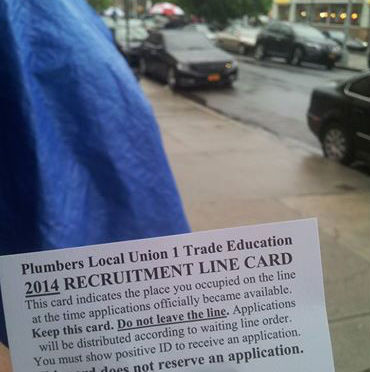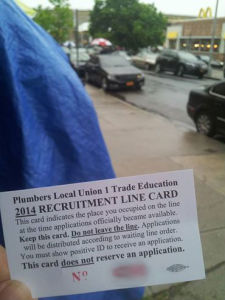My intention for this post is to share my experience, and for it to serve as a reference point/resource for women interested in entering the trades. This is continued series, so I hope you find some portion of this helpful! See all parts at this link: CLICK HERE – h!
Many of the women in my program arrived at this training program for the same reason: they couldn’t find good jobs anywhere. Many were unemployed, or just working a series of dead-end jobs, and were looking for ways to disrupt that cycle of poverty. This is why I wanted to head into the trades.
Research I did, and how I started:
First stop was, of course, the internet. I was able to find a program in the NYC area that focused on getting women into trade careers, and they offered a free orientation course for apprenticeships. Their training was six weeks long.
Second, I applied, interviewed, and was accepted into the trade orientation program for women. Our days consisted mostly of learning more about the various trades and associations in the area, simulating a construction site, carrying heavy loads (45-65 lbs. of various types of equipment up flights of stairs, and back), doing woodworking and electricity workshops, and learning more about green (environment-focused) trades. You have to be pretty quick at math, many of us learned, since you don’t have that much time to do complicated calculations when you’re busy at a site.
During this time, we also learned about various issues we’d face as women in a predominantly male industry. We learned about our rights at work, and how to address sexual harassment , should it arise. Other helpful workshops were about job attitudes, new trends in the trades (mostly headed toward green-minded technology), and refresher classes in math.
Third, I started speaking to the many lecturers we had. These women were also graduates of the program, and many were now journey-level in their careers. Many were involved in various associations which supported other women in the trades, usually referred to as a sisterhood. One of our mentors was a with a carpenters union for the last decade, so asking her about her profession really informed how I chose for which trade to apply.
I later found out that carpentry serves as the basis for the majority of trades, as much of what any tradesperson does is carpentry using different mediums. This was helpful to know, and made me more open to investigating other trades, as well.
Fourth, I completed the program, and placed fairly high on my various tests. This was sort of the easiest part for me, since I’m pretty much a nerd. What I found more challenging were some basic principles of building: sawing in a straight line, using a plane with a steady hand, not splitting the wood while you’re hammering in a nail, etc.
The other women in my cohort were also a pretty great bunch, so I really appreciated my learning experience more while with them.
At this point, I was also wrestling between the possibilities of applying to apprenticeships with the carpenters, electricians, or plumbers. I learned that for electricians and plumbers, the curriculum for apprenticeship was advanced in that it combined the 5-year apprenticeship trainings with a college degree. Because I was deathly scared of getting “blasted” by electricity, and that the carpenters unions were not opening up soon, I decided that I would try for the plumbing apprenticeship.
Fifth, we checked the DOL’s website a lot. Typically, if you are not coming from some kind of trade-prep training, this is the step where you would start.
In the state of New York, the Department of Labor runs ALL trade apprenticeship programs. This site lists all the days that certain unions are publicly recruiting. Depending on the trade, a certain number of applications would be handed out either on a specific date, or a range of dates. The number of applications is based on how many people the union or association can hire at that given time. Some applications are highly coveted, since their trades are high paying, and there are a limited number of positions.
One example of this is for the position of operating mechanic, whose main responsibility is operating large, heavy machinery like cranes and bulldozers on a worksite. Because there are only 14 cranes in NYC (this is a fact, btw, not an exaggeration), they only open up for recruitment every two years, and look to fill 1 or 2 positions. This is in stark contrast with a local carpenter’s union which opens up recruitment annually, and hires up to 200 new apprentices.
Looking over this boring ass website was more interesting to do with the other women in my program. The mutual support was very helpful and motivating for us all, and we went through these steps together. We were all interested in different kinds of work, but many of us made it a point to tag along in groups for application days.
Sixth, I got a union application. Right around the time that I completed my training program, the local plumbers union was opening up for public recruitment.
The plumbers were last open 8 months ago, were handing out 600 applications, but only hiring 100 apprentices. The applications were going to be handed out on a Monday, but we were tipped to be there earlier, and we were strongly urged to even sleep on the line as early as the Friday prior. Standing “on the line” for your application is almost a point of pride for any tradesperson, serving as a symbol of earned rank through hard work and discipline.
Coming from a land of submitting my résumé through LinkedIn, lining up for an application was a completely foreign concept to me. But as the sharp women from my cohort stated: if people have the time to line up for days just for the latest iPhone or some sneakers, why can’t they line up for a job? True. A number of us in my cohort were also interested in the plumbing apprenticeship, so we were able to schedule who’d be present on the line on each day fairly easily.
Because we were in the middle of summer, the conditions on the line were not harsh. Many brought lawn chairs, coolers, and grills as if this were one big tailgate. I even got a free steak and some hot dogs from the guys who were grilling two cars down. Some people parked nearby and slept in their car, others slept on chairs in the line as it wrapped around for blocks. We used a local McDonalds for its rest room. This lasted for three days for most, luckily my friends and I each rotated our places in line. I slept on the line for one night, and I got a spider bite – luck of the draw!
Seventh, I submitted my application. When Monday arrived, we were given a slip with a number on it. And then, we proceeded inside the union hall to pick up the full application. Seen:
And yes, that is a blue tarp, because on the last day, the rains fell upon us without mercy. (If you look even closer, you’ll also see the McDonald’s where I brushed my teeth.) Having secured my place in the 300s, I felt awful for the poor person who was #601 on line. They were not going to receive an application.
Once inside, our ticket number was married with our application form (I’ve blurred it here, since my application is still being processed), and we were instructed to return it completed in one month. The application was very straightforward (with all needed info) and pretty easy to fill out, and included the following:
- some basic contact information,
- job history stuff,
- a checkmark that stated you are able to pass a drug test (this is where I hear so many people DO NOT make the cut, so please ensure that you are free of any substances when eventually taking your drug test.)
- the results of my TABE test (Test of Adult Basic Education, a mandatory standardized test which I took at the assigned facility for free. As of this writing, the needed score to pass for this was a 10 out of a 12.9 scale),
- and your sealed high school transcripts.
I made sure to ask to whom to address and send the transcripts, just in case.
Then, I returned one month later to submit. There was only a 4 day period to do this, and there were specific time blocks during the day that applications were accepted. I arrived early anyway on submission day, and I received a receipt of confirmation. Because my high school mailed my transcripts directly to them, I called a week before to make sure that my documents were received. As an added precaution, I also attached a note within my application explaining that I had called on such-and-such date, and Mr.this-and-that confirmed that the union had my sealed transcripts.
Which brings us to now…
I’m extremely grateful to my cohort for their support, and willingness to make this work for all of us! I am now waiting to hear back from the union for an interview date, and then take an aptitude test. Those would be the last two steps in this process, and I would either be accepted or rejected as a new apprentice. As of this writing, I am not in the trades, and who knows if I’ll be in a position to accept if I get an offer? Wish me luck anyway, and I’ll update in Part 3!


1 Comment